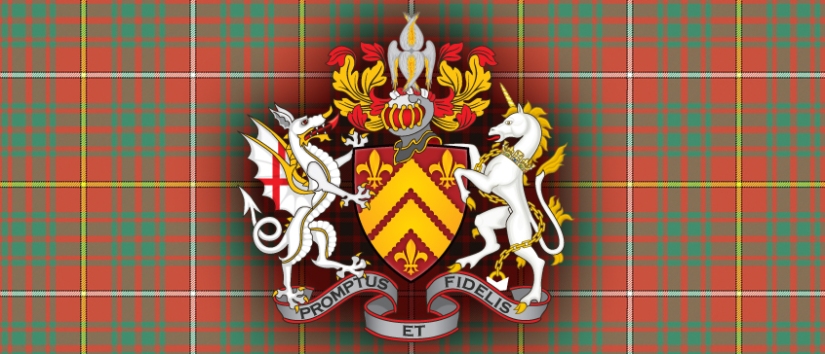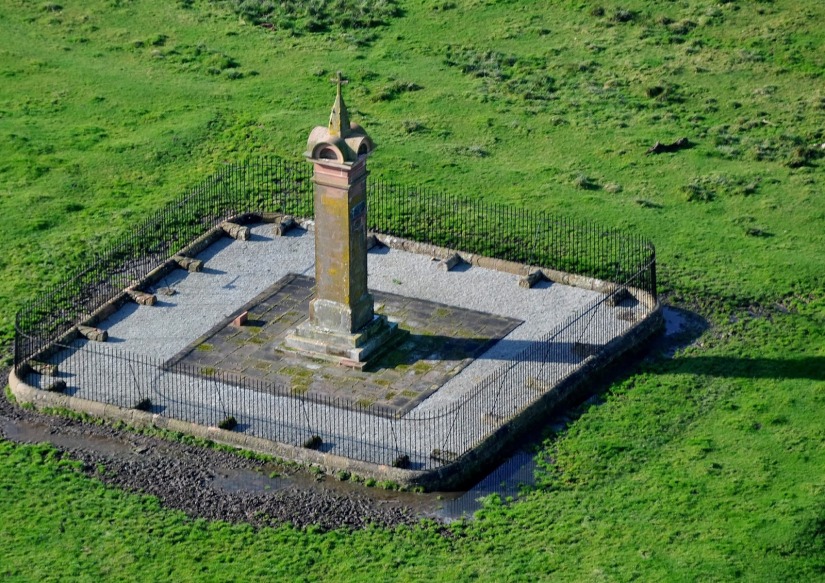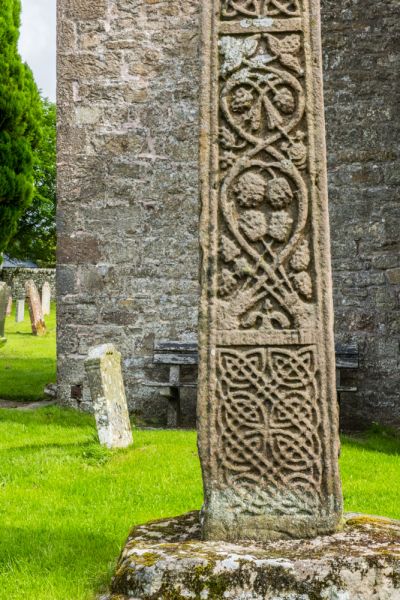
DID THE BORDER REIVERS PLAY OFFENSE OF DEFENSE

“I read with disbelief your report on the proposed statue in Dumfries commemorating the Border Reivers. Do members of the Trust Fund not realise that the reivers were a bunch of lawless, murdering thugs who brought terror to innocent people and shame on the name of Scotland? Certainly there were faults on both sides of the Border and the reivers took full advantage of the situation, but the history of their long period of aggression is among the most shameless episodes in the annals of the two countries. To commemorate this by raising a statue is beyond comprehension, especially as tourism is so important in this area and alienation of our southern neighbours would surely result”.
Interesting and forthright and certainly an opinion held by many.
I have wandered the Border lands of both England and Scotland for many years now and visited over seven hundred sites associated with the Border Reivers. You could say I am passionate about understanding their history and times. Along the way I have met many people: farmers, shepherds, walkers, historians, both of a bent for industrial heritage and those who search for the secrets of the people of early medieval roots and earlier. I have often met a similar approach to the one held above when conversation turns to my interests and the Reivers. The words “thugs”, “lawless” and “murderers” seem to epitomise the knowledge and feelings of many people. Not all, but certainly a sizeable majority of the folk I have met in my sojourns among the hills and valleys, the bog and bent of the beautiful Border country.
Whilst I endeavour to respect all opinions and listen with avid interest and a reticence to challenge, I feel that there is another side to the story.
I hope that what follows might help to promote a more balanced view on the lives and times of the Border Reivers by documenting , if only in a brief encounter, the history of the Border country before and in the centuries that the Border Reivers rode the land.
If we were to consider as the beginning of the strife that engulfed the Border country of England and Scotland the impasse that existed between the Scottish king, John Balliol, and Edward1, king of England in 1295/6, then we have a foundation for the reasons why the people of the Border country resorted to thieving and the inevitable consequences that followed from this: murder, feud, blackmail and extortion.
Actually the strife began much earlier, in medieval times, before the existence of Scotland and England as we know it today, when several kingdoms, each vying for supremacy, were the makeup of the lands to the north and south of the rivers Tweed and Esk. Then the kingdom of Strathclyde Cumbria fought with the Angles of Northumbria for control of the lucrative lands of what is now northern England and southern Scotland.
From those earlier medieval times and the Battle of Degsastan in the year 603 (one of the sites considered for this monumental confrontation between Strathclyde and Northumbria was Hudshouse Rig in Liddesdale, Roxburgh, Scottish Borders) to the fall of Berwick at the hands of the army of Edward 1 in 1296, it was the ordinary folk of the Border country who suffered loss of life and livelihood in the wake of marauding armies.
The Venerable Bede, writer of the Ecclesiastical History of the English Nation, writing in about 731, tells us that prior to the Battle of Degsastan in 603 and the victory of Northumbria over Strathclyde Cumbria that the land around the battle area was cleared of its people before the battle commenced.
Later, following the Norman Conquest of England, William the Bastard, known to us as William 1 or William the Conqueror waged war on the northern earls of Northumbria for control of Yorkshire, Durham, Northumberland and southern Scotland. They were all part of the Anglian territory that did not yield easy to his control.
The people of what is now the Border country were certainly not engaged in the confrontations, not part of the armies that trampled, stole or burned the crops and stole the beasts to feed a hungry horde of callous aggression on the move. Moreover it was the policy of any army that infiltrated the lands on its relentless march to a stand off with its arch enemy to rid the land of its peasant community less it should rise in resistance then or at a later date.
Thus for over six hundred years the lands which would become part of the modern English Scottish Border, and more importantly, its people, were to suffer every form of deprivation as they succumbed to the power of marauding armies.
Just one little piece of history to further cement the facts that the people of the area were totally abused, viewed as little better than animals.
In the year 1069, William the Conqueror, Norman ruler of England, endeavoured to bring the Anglian earls of Northumbria to heel. Unsuccessful in the direct approach of military confrontation, he resorted to the callous murder of the whole of the inhabitants of Yorkshire. The logic? No people, no crops, no beasts. The result – starvation for the northern earls!
Who took advantage of the situation whilst the Northumbrians were engaged in defending this devastating and unholy attempt to grind Northumbria into the dust and break its power for all time?
The Scots! They invaded Northumberland and burned and murdered at will.
Again and again the people whose descendants would inhabit the lands now known as the Border lands would be caught in a vicious maelstrom of death and loss.
At the more modern end of this little consideration, we find that John Balliol, king of Scots, having been humiliated once too often by the English king, Edward 1, made a treaty with the French in 1295, invaded northern England and laid the land waste. We are to assume, rightly, I think, that the people suffered great loss of life and livelihood.
In retaliation Edward 1’s Sack of Berwick and his triumphant march through Scotland, his stripping the kingship of Scotland from John Balliol and the subsequent wars of Scottish Independence led to two hundred and fifty years of enmity between the two nations. From the Battle of Stirling Bridge in 1297 to the Battle of Pinkie in 1547, war on an intermittent basis reigned between the two countries. Whilst there were resounding victories on both sides, who can forget the success of the Scots at Stirling Bridge under Wallace and Murray or its humiliation at Flodden in 1513, the outcome was always that of stalemate, followed by strenuous efforts to achieve supremacy. To the ordinary folk of the Border country, the clans and families who lived in the vicinity of the English Scottish Border, the outcome was predictable.
These wars, ostensibly between the armies of two nations, had as a by-product, the subjugation of the people who got in the way of the relentless march to north or south. They suffered untold abuse and deprivation but they are little mentioned in the quest for supremacy. Their lives were of no consequence in the scheme of things. They suffered and died but figured little in the grand design.
For instance, consider the aftermath of the Battle of Stirling Bridge in 1297, a resounding victory for the Scots led by Andrew Murray and William Wallace. Fired by triumph over the supercilious English, the Scots invaded northern England. During these savage raids the peasant stock suffered at the hands of the Scots as a result of a confrontation that had nothing to do with them or their tenuous hold on life, but suffer they did. Wallace even vented his wrath on the church when he destroyed part of Lanercost Priory in northern Cumbria.
After the Scottish victory at the Battle of Bannockburn in 1314, the Scots celebrated their success by a series of savage and relentless raids into northern England. The results of their depredations were surely predictable. A people already living in a hell-hole after centuries of penury, killed or left starving as crops and beasts were burned or stolen.
In 1346, David II invaded England. He would fail miserably at the Battle of Neville’s Cross but not before he had raided and devastated Cumbria. At the Mote of Liddel (near modern day Longtown), he invested the castle, succeeded in bringing it down and strangled the two sons of the Royal Constable, Walter Selby. Selby was made to watch this atrocious act before he, himself, was killed whilst begging for mercy to make his peace with God and to die like a knight. His pleas were refused. It can surely be guessed what happened to the rest of humanity living in the area.
Following the victory at Flodden in 1513, within weeks, the English were raiding Teviotdale and Annandale in the Scottish Borders and exacting a great price from a people who were defenceless against the storm of arms that confronted them.
In the 1540’s Henry V111 of England endeavoured to cement a union between England and Scotland through the marriage of his son, Edward, to the infant Mary who would become Queen of Scots. His efforts failed when the Scots reneged on the deal. Henry, suffuse with hatred for the Scots, and smarting at what he perceived as double dealing, invaded the Borders and the Lothians. His edict was clear “put all to the sword”, and he surely did. The Scottish Borders were yet again laid waste, the people, men, women and children killed.
Throughout the centuries, from the 14th to the 17th, there are many recorded instances of raids, both north and south of the English Scottish Border Line. To follow are but a few; they demonstrate clearly that the ordinary folk living in the area on both sides of the frontier were subject to every atrocity that a marauding army could devise, use and perpetrate:
In 1342 David Bruce, king of Scots, invaded England and laid waste the English counties of Northumberland and Durham.
In 1345 the Scots raided Westmorland and burned Penrith and Carlisle. Between 1345 and 1356 the Scots raided England and devastated the English Borders.
In 1402 the Earl of Douglas invaded England, burned, killed and harried on his journey south but was defeated at the Battle of Homildon Hill (Wooler in Northumberland).
Between 1417 and 1419 Robert Umfraville invaded Scotland relentlessly and burned Hawick, Jedburgh, Selkirk, Berwick, Dunbar and the forest of Teviotdale.
By 1430, as the counties of Northumberland and Cumberland had been continually laid waste by the Scots, the English crown decided to forego all taxes and debts due from the impoverished counties.
In 1448 the Earl of Northumberland destroyed Dumfries (Scotland). In revenge Douglas burned Alnwick (Northumberland) and devastated Cumberland.
Even up to 1587, the hostility rolled on, burgeoned and reigned. In six successive raids the Scots laid the north of England devoid of crop or beast. Many folk died protecting their homes and livelihoods. The “country was reduced to a desert, wasted with fire and sword and filled with lamentation and dismay”.

Just a flavour of the lives and times of the Border people on both sides of the Border Line down to the Union of the two crowns of England and Scotland in 1603.
So, given the history, we are surely left with an understanding that the people on both sides of the Border were abused for centuries. How were those who managed to survive the holocaust to hold body and soul together in a land that was wasted in generation after generation?
It is not a question that requires much thought.
To survive these people had to steal what they could, where they could.
They became what we know today as the Border Reivers. To “Reive” is to rob or steal, from an old English word.
To view the Border Reivers as “a bunch of lawless, murdering thugs “ then is an opinion that results from the outcomes of their way of life with little knowledge of the origins which created their society.
True they were “lawless”. What people wouldn’t be in a land that was relentlessly savaged and shown little or no support from monarchy, government or society?
Consider also the fact that as diplomatic relations between England and Scotland wavered between all out allegiance and downright enmity for centuries, the Border people, on both sides, the best light cavalry men in Europe, were often viewed as the perfect foil to inroads from the opposite country. Both sides acted as a buffer state between two of the most warlike and aggressive nations in world history. In times of enmity and sour relations with the neighbouring country, authority and monarchy ‘looked through their fingers’ at the burgeoning crime, encouraged their people to harry the opposite side of the Border Line. At times when peace endeavoured to prevail, the same monarchies and governments sought to rid the Borders of a people whom they considered an embarrassment to peace.

It is easy to see why the Border folk held allegiance only to their own clans and families. The clan or family became the only means of unity, aid and solace when they were abandoned by the leaders of society who used, abused and abandoned them during the centuries of want.
In the late 1520’s, for example, Sim Armstrong, the Laird of Whithaugh, (Newcastleton, Liddesdale, Scottish Borders) talking with the Earl of Northumberland, said that there would be no peace in Scotland until an English king ruled there.
In essence his words rang true. The Scottish monarchy, weak and impoverished, had done little to foster good relations with its Border people. Rather it had sought to control through pandering to the prominent war lords, in the south-west especially. Turn by turn, these leaders of the foremost clans were invested with overall power yet ruled on a biased basis where old allies within the community, some with a shameful record of crime, were treated as pillars of society; traditional enemies to the leader, hounded and harried.
It is too easy to view the Border Reivers also as “murdering thugs”.
Feud became, in the words of James V1 and 1st, the “canker” of the Border lands as confrontation between the clans and families as they robbed from each other, led to a total breakdown of an equitable, sharing society. To steal from anyone is a crime; to steal from erstwhile neighbour or friend, anathema. Yet to the Border folk this was often the only means open to ensure their survival. The feud was predictable as clans and families swore to right the wrongs that had been committed against them. In the full-blooded attacks to steal and the equally robust attempts at defence of property, murder and death were the inevitable results.
Consider the accusation “brought terror on innocent people and shame on the name of Scotland”. It would be hard to estimate how many people in the Scottish English Border lands were “innocent”. There are documented records of seemingly innocent people being attacked and shorn of their livelihoods, yet it is likely in a broken society that they had allied themselves to one of the clans or families for support. As such they were viewed as belonging to the “enemy” in any feud that might ensue.
The real “shame” should be directed against both the domestic and foreign policies of Scotland and England.
They deserted the Border people in their hour of need; not only through a lack of involvement for long periods and a paucity of concern for their welfare down the centuries, but through the lack of meaningful and honourable authority and government.
Authority set in place to control the Border Reivers was often corrupt, ever-ready to profit from the nefarious activities of the people under their jurisdiction, or weak and vacillating when a strong hand was necessary.
We first know of the Border Laws in 1222 and the March Wardens in 1237. The laws were amended many times down to 1596 in an endeavour to curtail the Reiving but signally failed.
The crime of murder was still a major problem down to the Union of the Crowns in 1603. So much for the Border Laws and the March Wardens who were charged with bringing the lands of the Scottish English Border to order. Perhaps they pandered to two governments who were vacillating and expedient in their authority!

OFFICIAL AND REGISTEREDL CLAN CARRUTHERS CCIS SINCE 1983-CLAN OF OUR ANCESTORS
SCOTTISH CLAN – IRISH CLAN – NORSE CLAN
Preserving Our Past! Recording Our Present! Informing Our Future!
The Ancient and Honorable Carruthers Clan
carruthersclan1@gmail.com CLANCARRUTHERS1@GMAIL.COM

CLAN ARMSTRONG – BORDER REIVER AND HIGHLAND CLAN
CLAN CARRUTHERS INT SOCIETY CCIS HISTORIAN AND GENEALOGIST

You can find us on our main facebook pages at :
SILVER WINGS-https://www.facebook.com/CarruthersClanLLC/
GOLD WINGS – https://www.facebook.com/carrutherscarrothers.pat.9
CLAN CARRUTHERS FAMILY HISTORY – https://www.facebook.com/CarruthersClan
CLAN CARRUTHERS CCIS – https://www.facebook.com/groups/3878691252182714
CLAN CARRUTHERS INT SOCIETY- https://www.facebook.com/groups/394653845137709
CLAN CARRUTHERS – BORDER REIVERS – https://www.facebook.com/groups/434959914239094
Disclaimer Ancient and Honorable Carruthers Clan International Societ








 STATUE OF EDWARD I
STATUE OF EDWARD I












 Hobbie Noble had distinguished himself by playing a prominent part in effecting the escape of the Armstrong, Jock o’ the Syde, from Newcastle jail. Hobbie was an Englishman, born in Cumbria, but his misdeeds were many, and he was forced to flee to Scotland to escape the law. There, in Scotland, he attached himself to the Armstrongs, who were the most active and troublesome of all the reiving families.
Hobbie Noble had distinguished himself by playing a prominent part in effecting the escape of the Armstrong, Jock o’ the Syde, from Newcastle jail. Hobbie was an Englishman, born in Cumbria, but his misdeeds were many, and he was forced to flee to Scotland to escape the law. There, in Scotland, he attached himself to the Armstrongs, who were the most active and troublesome of all the reiving families. BEWCASTLE STONE
BEWCASTLE STONE